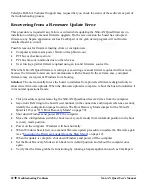
42
Theory of Operation
X64-AN Quad User's Manual
Figure 23: External Trigger Input
Let
t(et) = time of external trigger in
s
t(vt) = time of validated trigger in
s
t(oc) = time opto-coupler takes to change state
t(d) = debouncing duration from 1 to 255
s
trigger high
For an active high external trigger, t(oc) = 10
s:
t(vt) = t(et) + 10
s + t(d)
trigger low
For an active low external trigger, t(oc) = 50
s:
t(vt) = t(et) + 50
s + t(d)
Note: Teledyne
DALSA recommends using an active high external trigger to minimize the time it
takes for the opto-coupler to change state. Specifically, the opto-coupler response time is 10
s for
active high compared to 50
s for active low.
If the duration of the external trigger is > t(oc) + t(d), then a valid acquisition trigger is detected.
Therefore, the external pulse with active high polarity must be at least 11
s (if debounce time is set to
1) in order to be acknowledged. Any pulse larger than 51
s is always considered valid.
It is possible to emulate an external trigger using the software trigger which is generated by a function
call from an application.
External trigger input is available on J5, a DB9 connector (see “J5 – Trigger Signals Connector” on
page 65). The X64-AN Quad external trigger interfaces to the external world through the use of an
opto-coupled device. Formed by a LED emitter combined with a photo-detector in close proximity, an
opto-coupler (or opto-isolator) connects the X64-AN Quad external trigger input and the user circuit
together while using separate grounds. This “galvanic isolation” approach prevents ground loops and
protects both circuits. A serial resistor limits the current.
















































